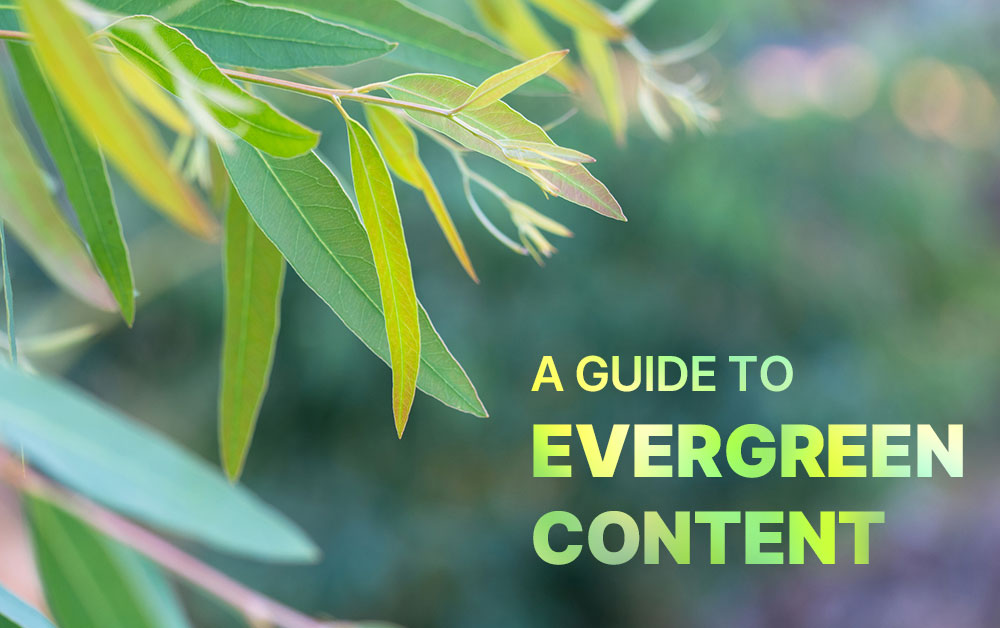The Ultimate Guide to Evergreen Content for Your Website

With the fast pace of information and news, it’s important to utilise long-lasting content on your website that doesn’t change or expire. This is what makes evergreen content a cornerstone of a good marketing and content strategy for your website.
In this guide, you’ll learn what evergreen content is, why it matters, the types you can use, how to create it, and tips to keep it fresh. We’ll also cover mistakes to avoid, how you can promote and reuse it, as well as provide tools and resources.
What Is Evergreen Content?
Evergreen content refers to website material that remains relevant and valuable to readers over time, regardless of current trends or events. Unlike time-sensitive content—such as news articles, event announcements, or seasonal promotions—evergreen pieces are designed to maintain their usefulness and search appeal for months or even years after publication. Examples include how-to guides, FAQs, beginner’s tutorials, and listicles that answer common questions or solve enduring problems.
Why does it matter for your website?
Because of its lasting nature, evergreen content consistently attracts organic traffic, supports ongoing SEO efforts, and delivers a strong return on investment with minimal upkeep. It is also valuable as high-traffic content that you can use to link to within your website.
Having a growing pool of evergreen content builds the trust that both users and search engines have in your site as well as your authority on the topic.
Types of Evergreen Content That Work Well
The exact type of content that works best for you will vary based on your business and goals, but the following are examples that work broadly for many industries.
How-to guides and tutorials
There are always going to be new people who don’t know how to do something or use a product. Guides and tutorials help the user learn and improves their goodwill towards your brand. E-commerce websites can use them to explain how to use their products.
Listicles and resource roundups
List-style articles and curated resource roundups present information in a clear, scannable structure that remains useful to readers long after publication.
Product reviews (non-seasonal)
Writing product reviews for items in your industry allows you to show off your expertise and increase your authority on a topic. Examples are cleaning companies reviewing design choices based on how easy they are to maintain and clean, or an IT company reviewing different software options.
Glossaries and definitions
Especially useful for industries that use a lot of jargon, glossaries can give users a single place they can go to when they’re unsure about a word used elsewhere on the site.
Case studies with long-lasting relevance
A good case study highlights the specific challenges for that project and how you, as the business, overcame those challenges. This ensures long-lasting relevance because it puts the focus on your adaptability and problem-solving skills, which can be transferred to any project.
FAQs and beginner’s guides
It is always a good idea to have a section on your site for frequently asked questions as this helps funnel users to information that they’re likely to be looking for. It also frees your time up because it reduces the number of phone-calls or emails you receive with the same questions. In the same vein, having a beginner guide answers most, if not all, of the questions someone will have about a product or topic.
How to Create Evergreen Content: A Step-by-Step Process
Step 1: Topic research and keyword planning
Before even deciding on what you’re going to write, do some research on different topics and what information people are looking for surrounding them. Once you have a topic, narrow your research to just that topic and plan out the keywords that you want to be found for and how they can integrate with your content.
Step 2: Understanding search intent
Learning about the search intent of your users can help you decide on what kind of evergreen content you want to put your energy into producing. Grasping the underlying goal behind a user's search query is essential for creating content that meets their needs and ranks well in search engine results.
Step 3: Writing for timelessness
Now that you have your research on the topic done, your keywords planned out, and you have a good understanding of the search intent of a user you’re ready to start writing. By using good grammar and clear structure, you can make content that doesn’t feel tied to a specific time and avoids sounding dated.
Step 4: Avoiding trends and date-sensitive language
Whilst trends can be a useful tool in your marketing toolbox, they are fast moving and change quickly—which is the opposite of evergreen content. Using trends or date-sensitive language in your content provides a clear idea of when the piece of content was written.
Step 5: Optimising for SEO
Since the main benefit of evergreen content is a boost to SEO you want to do as much as you can to maximise this boost. Make sure that any headings you use have the appropriate heading tags— Heading 1, Heading 2, Heading 3, or Heading 4— and ensure the page it's on has an optimised title and meta description.
Tips for Keeping Evergreen Content Fresh
Whilst evergreen content is always useful in its core message, you will need to do updates over time to maintain its relevance, accuracy, and SEO performance.
- Scheduling regular content audits to check for outdated information, broken links, or changes in best practices.
- Use analytics tools to monitor how the content is performing; a drop in traffic or engagement can signal it’s time for a refresh.
- Simple updates like adding current examples, embedding new media, or linking to recent authoritative sources can breathe new life into the piece. Just be mindful to preserve the core message and structure that made the content evergreen in the first place.
Common Mistakes to Avoid
While evergreen content offers long-term value, there are a few common pitfalls that can undermine its effectiveness if you're not careful.
- Relying solely on evergreen material can make your site feel static or outdated, so it’s important to balance it with timely, topical posts that keep your audience engaged.
- Even timeless content can lose value if it’s not updated periodically to reflect current standards, data, or best practices.
- Failing to adapt content based on audience feedback or changes in what people are searching for, and why, can result in lower engagement and reduced visibility.
- Failing to promote your evergreen content means that you miss out on fully leveraging its potential.
How to Get the Most Out of Your Content
Just having evergreen content on your site isn’t enough, you need to be promoting it to maintain visibility, attract new traffic, and maximise its long-term impact.
- Repurpose the content into bite-sized formats for social media—think quote graphics, short videos, or teaser posts linking back to the original article.
- Incorporate it into your email marketing funnels to nurture leads with relevant, high-quality information over time.
- Strategically feature your evergreen pieces on cornerstone pages or link to them internally from newer posts to boost SEO and guide visitors through your site.
- Reach out to relevant websites or blogs to encourage backlinks, which not only improve search rankings but also expand your content’s reach to new audiences.
Helpful Tools
Content planning tools
Content planning tools help streamline the process of organising, scheduling, and tracking your evergreen content. They allow you to map out topics, assign tasks, and set deadlines, making it easier to maintain a consistent publishing schedule and ensure your content strategy stays on track.
Examples
- Planable
- Notion
- Asana
- Trello
SEO Tools
SEO tools are essential for identifying high-impact keywords, analysing competitors, and tracking how your evergreen content performs in search results. These platforms provide valuable insights that help you optimise content for better visibility and long-term ranking.
Examples
- Ahrefs
- SEMrush
- Google Search Console
*****
Evergreen content is one of the most powerful tools in your content strategy—it works quietly in the background, driving consistent traffic, building trust with your audience, and boosting your SEO over time. By understanding what makes content evergreen and how to create, maintain, and promote it effectively, you can build a library of resources that continues to deliver value long after it’s published. Whether you’re just starting out or refining an existing content strategy, integrating evergreen content into your website is a smart, sustainable way to grow your online presence. Make it a priority, keep it updated, and let it do the heavy lifting for your digital marketing.





